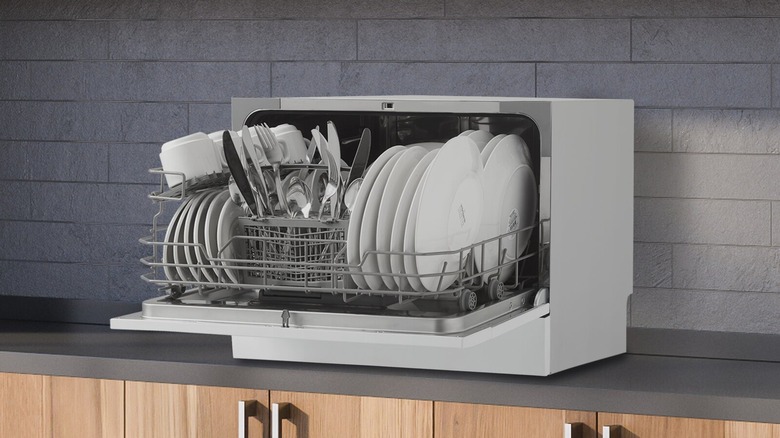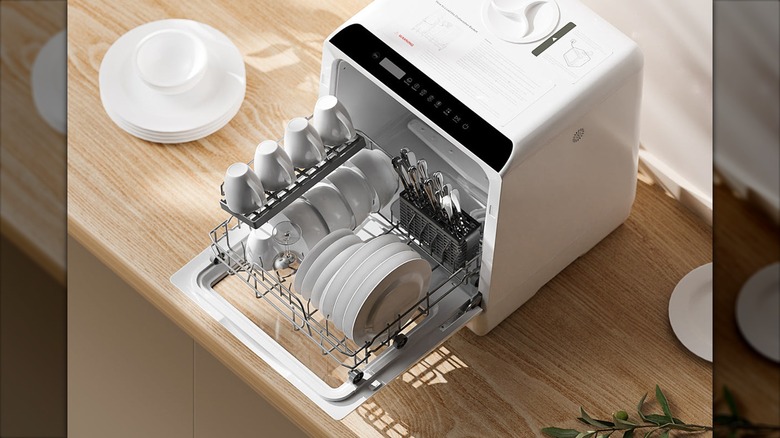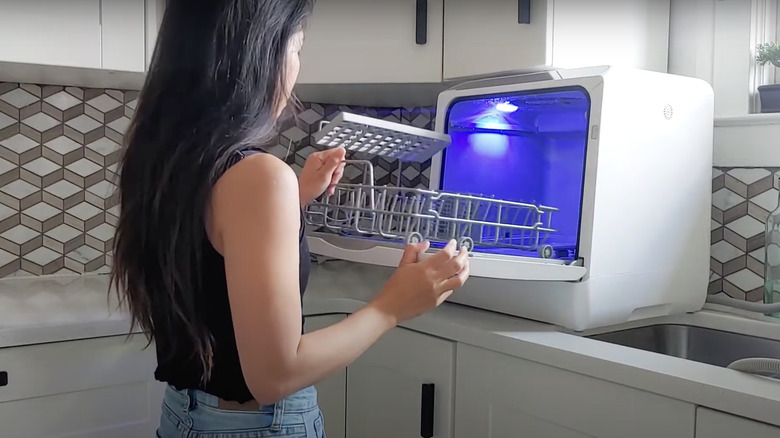How To Choose The Best Countertop Dishwasher That Serves Your Needs
Appliances are here to make our lives easier, and one task we're particularly happy to automate is washing dishes. No more bacteria-filled sponges, gallons of water down the drain, or wrinkly fingers — how luxurious. Unfortunately, not every kitchen is equipped with a dishwasher. For small apartments and kitchens, it might not be possible to install one. However, lacking space is not a problem thanks to the viral space-saving countertop dishwasher. The appliance sits on your counter and easily cleans dishware and cutlery. But not every dishwasher is made equally. When choosing the best countertop dishwasher for your kitchen, consider the appliance's size, wash cycles, and connection method.
A countertop dishwasher can be a great investment for your home, so you want a model that will fit your needs. The appliance's size determines how many dishes you can wash in one cycle, how much countertop space you lose, and if portability is an option. The type of wash cycles make a difference, too. Do you need a dishwasher to sanitize baby bottles and rinse produce, or is a standard wash for everyday dishes enough? Further, how the dishwasher connects to your plumbing can impact the overall cost to get the appliance running, the set-up time for each use, and your sink's usability. Keep these things in mind, and you'll pick the ideal mini dishwasher that will save you time, water, and energy.
Consider the dishwasher's size and washing capabilities
Size is one of the most important factors to consider when choosing the right dishwasher for your kitchen. How much counter space are you willing to sacrifice? There are compact options that are only 10 inches wide and full-sized models that are over 20 inches wide. Also, measure your available space to account for depth and height. The dishwasher should sit steadily on the counter and have clearance between its top and any upper cabinets.
Weight matters, too, if you prefer a portable countertop washer. Perhaps you only need the dishwasher during big weekend dinners and want to store it away when it's not in use. Then it's best to have an appliance that's easy to move to and fro. Keep in mind, lighter-weight dishwashers will most likely have a smaller capacity than heavier models. This can be the difference between washing two-plate settings in one cycle versus six or fitting 12-inch plates inside the rack versus 9-inch ones.
Another thing to consider is your cleaning needs. Apart from the standard wash cycle, some dishwashers offer a speed cycle, eco-friendly cycle, glass-care cycle, sanitizing cycle, dry cycle, and even a fruit-wash cycle. Think about the features you need and which you can forgo. Furthermore, look at the appliance's Energy Star rating. An Energy Star-certified dishwasher can save you water, energy, and money. It's good for you and the planet.
Connection method can be a determining factor
One major difference between the various countertop dishwashers on the market lies in how they connect to the plumbing. There are three main connection methods — a permanent connection to your plumbing, a temporary attachment to the sink faucet, and a manually-filled water tank. Permanent-connection dishwashers hook up to your water line, much like a full-size dishwasher. Once installed, the appliance is ready-to-use. It's best to have a plumber install these models for a guaranteed fit.
With a connecting pipe, the dishwasher is placed near the sink and attached to the faucet with an inlet hose. Usually, you remove the faucet's aerator to mount the connecting hose. Some dishwashers may require an additional adapter to fit onto your tap head. You can install these models yourself. However, while the dishwasher is running, your faucet will be out of commission.
With built-in water tanks, no installation or hook ups are required. You simply use a pitcher to fill the dishwasher's reservoir with water and turn it on. It gives you a little more flexibility since you don't have to place the appliance next to the sink. However, if it's not near the sink, you'll need a container to catch the used water. Some of these models also come with a hose to connect the dishwasher to the faucet, giving you installation options. With any version, you can enjoy clean dishes that you didn't have to hand-clean.


